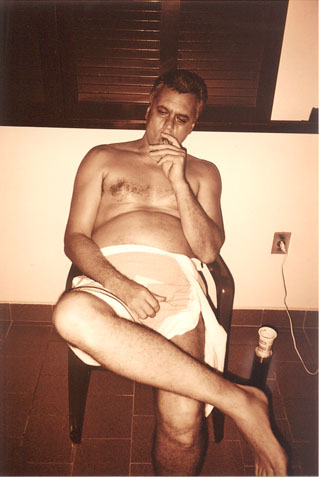
Last night Dr. Batista stood over the statue that had just been carved in his likeness. He ran his hand over the smooth marble, then looked down at his fingers to see if they had picked up any marble dust off the surface. He stared at the statue built to his body's exact proportions, and as he scrutinized it, his face showed neither approval nor disgust.
The statue depicts Batista lying on his side, his head and shoulders propped on a large cushion, cigar in hand. He has a towel wrapped around his waist, and a large belly bulges over the towel's edge.
Then I woke up.
Yes, it was a dream. I had been looking at my Brazil photos before going to sleep.
The photo that inspired the statue in my dream was taken a few seconds after the beginning of the year 2000. I was at the beachside cottage with Dr. Batista and his family. We had popped the champagne, began eating the first of 12 grapes, one for good luck in each month of the coming year. I had my camera nearby and motioned to Dr. Batista to get up from his chair and join in a photo with his daughter, son, and wife. He sat there in his chair and waved his cigar disapprovingly at me. "No, I will stay here," he said. I was giddy and smiling with New Year cheer, and I thought, "O.K., if the mountain won't come to me, I'll come to it." So I walked over to where he was seated and snapped one photo.
It was precisely four months later that I received my developed film from the lab. I looked at the photo that I had taken, and I could see how the flash on my camera had illuminated the scene in such a way that I could see small details, four months and thousands of miles later, that I could not see in the darkness when I took the picture.
He is puffing on the ever-present cigar, a beach towel around his waist. At the moment I took the photo, I was filled with the happiness of the new millenium, and everyone around us was celebrating. Batista was not much for flair; as you can see, he did not even want to get up for a photo with family. The flash illuminated his travel humidor, a cylindrical metal tube that is lined with cedar and has a black, rubber O-ring to maintain the right amount of humidity to prevent the cigars from drying out. I will remember the way he would sweep his big arms down by the side of his chair, his fingers feeling around on the ground for his humidor the way an elephant searches for peanuts. He would locate the cylinder and pick it up, beginning the ritual of trimming, igniting and puffing which he performed with delicacy and skill wherever he went.
There is a small white cup sitting atop his humidor, which he used as a spitoon for bits of tobacco that flaked off the cigar as he smoked. The cup is one of those small things that show up in the corner of a photo. It's small, but important. It gives you a feel for the moment, and the detail that exists in Batista's life. Without it, there's spit on the floor, it's a mess. The organization of the humidor and white cup tell something about Batista; I think it's the surgeon in him. He knows there's a place for everything, and spit doesn't go on the floor.
The big details in this photo? Batista is a loner. His independence kept him out of the group photo. It was enough for him to sit in the corner of the room, smoke his cigar and watch others enjoy themselves.
This is the photo I looked at before I fell asleep, this exact likeness carved into the marble sculpture of my dream.
